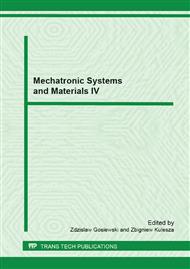p.138
p.144
p.153
p.159
p.165
p.171
p.176
p.182
p.188
Algorithms of Measurement System for a Micro UAV
Abstract:
The article presents a measurement system for a micro UAV designed at the Department of Avionics and Control Systems of Rzeszów University of Technology. Since the project is based on earlier projects, e.g.[[[[1[[[1, the introduction begins with their short presentation [they are mentioned in the introduction firs. Then, the current project is discussed. The major objective of the project is to create a miniature autopilot cooperating with navigation units, data transmission units and measurement units. The system is based on Polish technological solutions. The autopilot is designed as a single unit, however the system is open and it allows you to use different elements. The system development is also possible. In-flight testing will be realized with the use of two unmanned flying platforms equipped with an electrical engine and a piston engine. The total mass of the platforms is 5 kg and 25 kg respectively. The article presents the structure of the control and navigation system and then, the structure of the measurement system. The measurement units consist of a GPS receiver, an attitude and heading reference system (AHRS) and an air data computer (ADC). Similar configuration is used in other micro UAV solutions, such as Micropilot or Kestrel. Then, algorithms of the measurement system are described. Navigation is based on GPS data with a DGPS (Differential GPS) advanced module. If the measurement information is complete, GPS data are used to correct measurements from other units. The system estimates wind disturbances and calculates accelerometers errors. In the case of missing GPS signals implementation of low-cost sensors may lead to significant measurement errors, and hence navigation only by means of the INS is impossible. In such a case, navigation is realized with the use of an inertial navigation system (INS), the magnetic heading measurement and ADC. AHRS unit algorithms use quaternion algebra for attitude calculation. For correction, complementary filtering is implemented [, [. The correction signal for the attitude (pitch and roll angles) is calculated with the use of acceleration measurements. Measurements of accelerations and yaw rates are used for the correction switching mechanism, since in dynamic states signals calculated from accelerations cannot be used for correction. Heading is corrected by means of magnetic heading measurement. ADC algorithms are based on typical aerodynamic dependences.
Info:
Periodical:
Pages:
165-170
Citation:
Online since:
March 2013
Authors:
Keywords:
Price:
Сopyright:
© 2013 Trans Tech Publications Ltd. All Rights Reserved
Share:
Citation:


